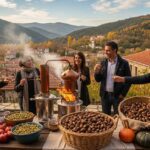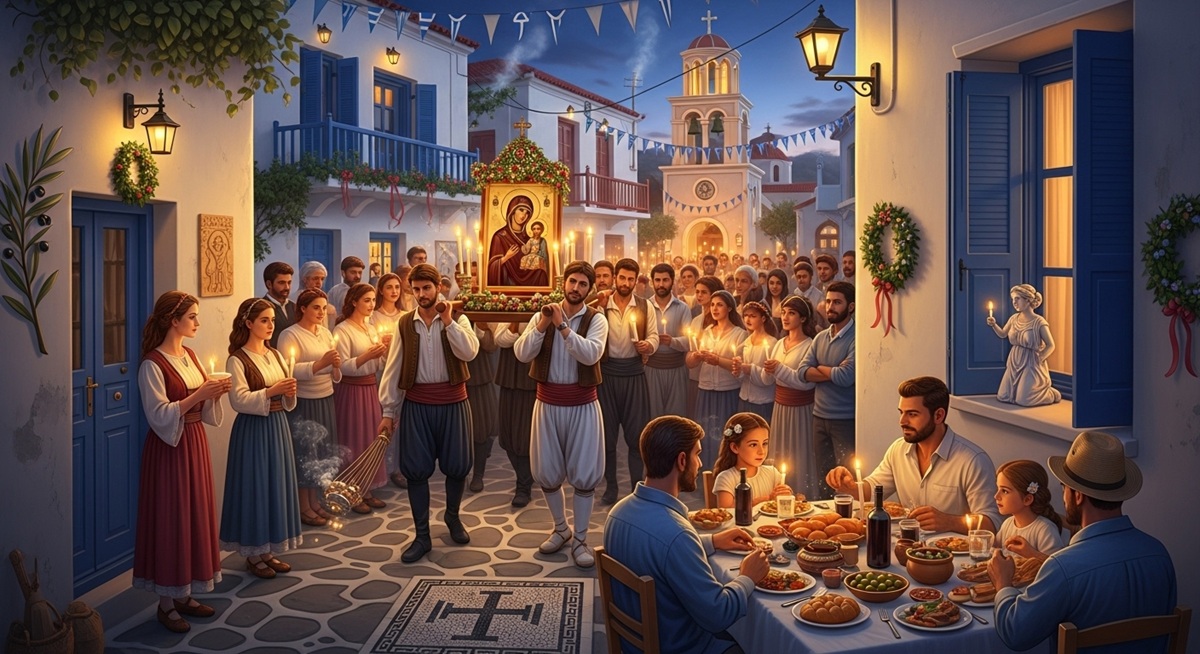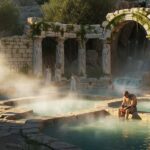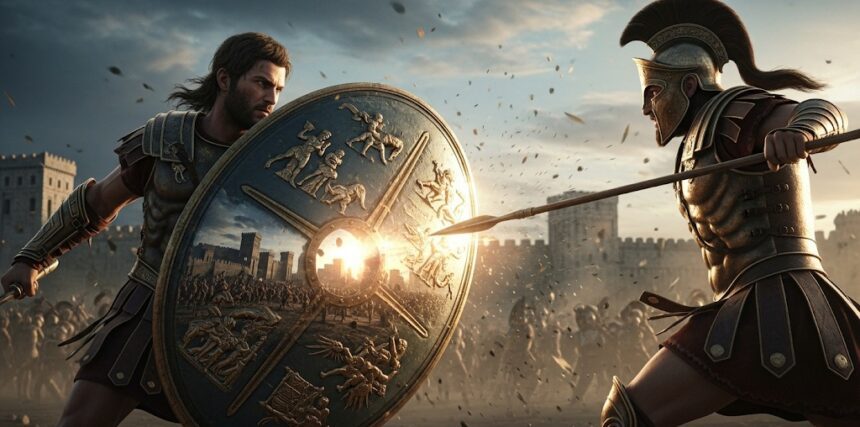Every year on August 15th, Greece transforms into a tapestry of faith, festivity, and folklore. This date marks the Dormition of the Virgin Mary, or Koimisis tis Theotokou in Greek, a profound Orthodox Christian holiday honoring Panagia, the All-Holy Mother of God. Villages light up with candlelit processions, churches overflow with hymns, and families gather for feasts that blend solemn reverence with joyous community spirit. Pilgrims flock to sacred sites, carrying icons and offerings, while the air fills with the scent of incense and freshly baked bread.
Yet, peel back the layers of this Christian celebration, and you’ll uncover vibrations of a much older world—the realm of ancient Greek mythology. Here, powerful mother figures like Gaia, Demeter, and Rhea once reigned, embodying fertility, protection, and the earth’s bounty. Scholars and cultural historians note how these archetypes seamlessly transitioned into the veneration of Panagia, creating a unique fusion where pagan rites meet Orthodox devotion.
The Sacred Feminine Across Time
The concept of the sacred feminine runs deep in Greek culture, evolving from primordial earth mothers to the celestial grace of Panagia. This continuity isn’t just symbolic; it’s embedded into the symphony of seasonal cycles, harvest traditions, and communal worship. As the Dormition of the Virgin Mary coincides with the peak of summer’s bounty, it mirrors ancient festivals honoring life-giving deities. Let’s delve into these archetypal figures and their lingering influence.
Gaia – The First Mother
In Greek mythology, Gaia was the ultimate primordial force—the Earth personified. Born from chaos, she birthed the skies, seas, and Titans, symbolizing the nurturing womb of creation. Her worship involved offerings of fruits and grains, rituals that celebrated the land’s fertility and stability. Today, during August 15th celebrations, pilgrims bless similar harvests in churches dedicated to Panagia, invoking her as a heavenly protector who sustains life much like Gaia did the earth.
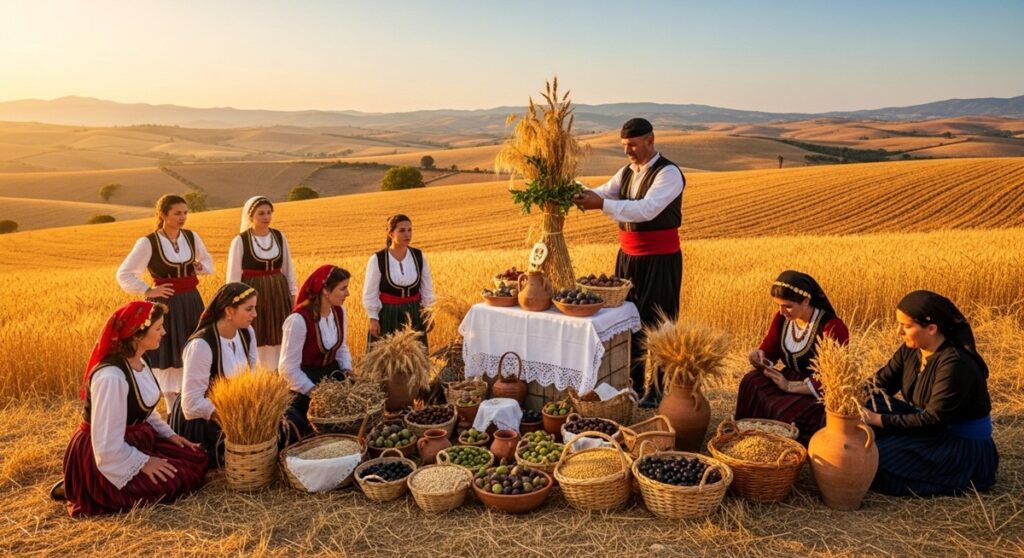
This connection is vivid in rural Greece, where the holiday aligns with the grain cycle’s “dead period,” a time of renewal that echoes Gaia‘s regenerative powers. Imagine standing in a sun-drenched field, watching villagers offer figs and olives—tokens that bridge the terrestrial and divine.
Rhea – Mother of the Olympians
Rhea, consort to Cronus and mother to Zeus and his siblings, embodied maternal protection and cunning. She famously saved her children from her husband’s wrath, hiding them in sacred groves. Her cults emphasized fertility rites, with bread, grapes, and flowers as offerings—elements that strikingly parallel modern August 15th processions.
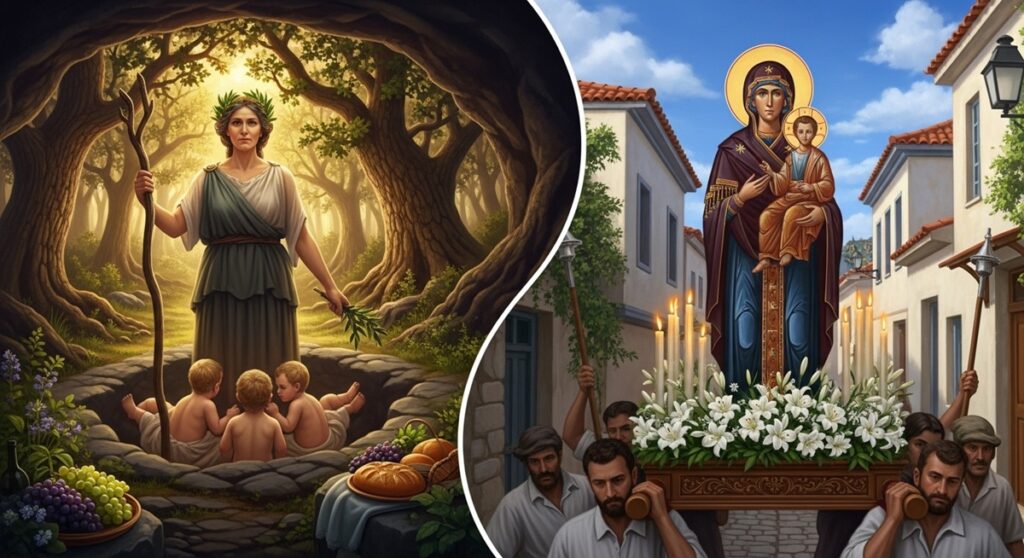
In Orthodox tradition, Panagia is hailed as the ultimate protectress, her icons carried through streets amid chants for safeguarding families. This maternal thread suggests a cultural inheritance, where Rhea‘s fierce guardianship evolves into Panagia‘s intercessory role. It’s a reminder that in Greece, motherhood—divine or earthly—has always been a force of resilience.
Demeter – The Harvest Mother
Perhaps no goddess aligns more closely with the Dormition than Demeter, the sorrowful mother of Persephone and patroness of agriculture. Her Eleusinian Mysteries celebrated the cycle of death and rebirth, with August marking the height of harvests dedicated to her. Grapes, wheat, and figs were central, symbolizing abundance and renewal.
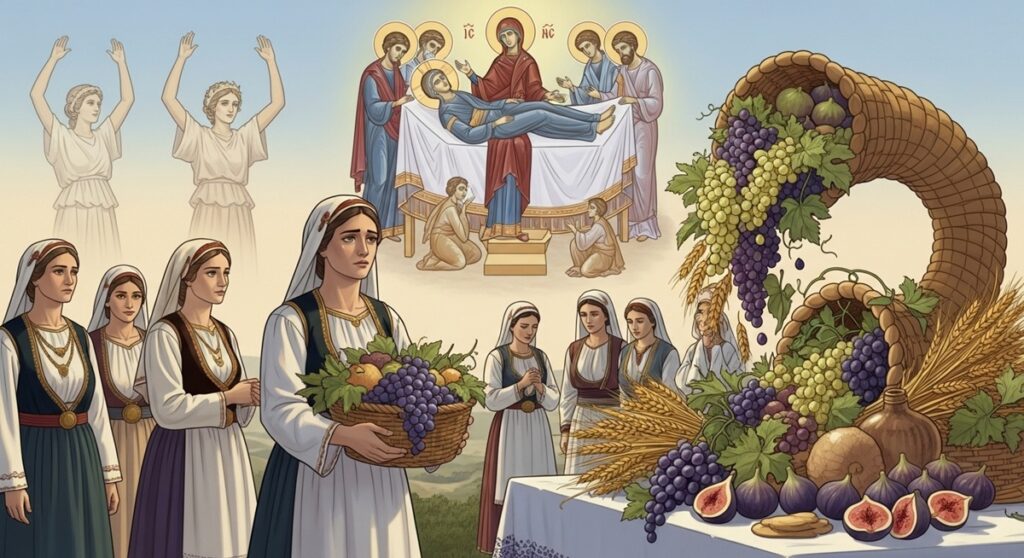
Fast-forward to today: August 15th falls during Greece’s harvest peak, where these same foods are blessed in Panagia‘s name. In villages, women lead rituals that evoke Demeter‘s mourning and joy, blending Christian Dormition themes with pagan fertility echoes. This synergy highlights how Greece’s Orthodox faith absorbed ancient agrarian spirituality.
Cybele – The Great Mother from Anatolia
Influenced by Anatolian roots, Cybele—the Phrygian “Great Mother”—was adopted into Greek worship as a wild, ecstatic deity of mountains and fertility. Her rites involved music, dances, and offerings to ensure bountiful lands, often linked to Rhea as her counterpart.
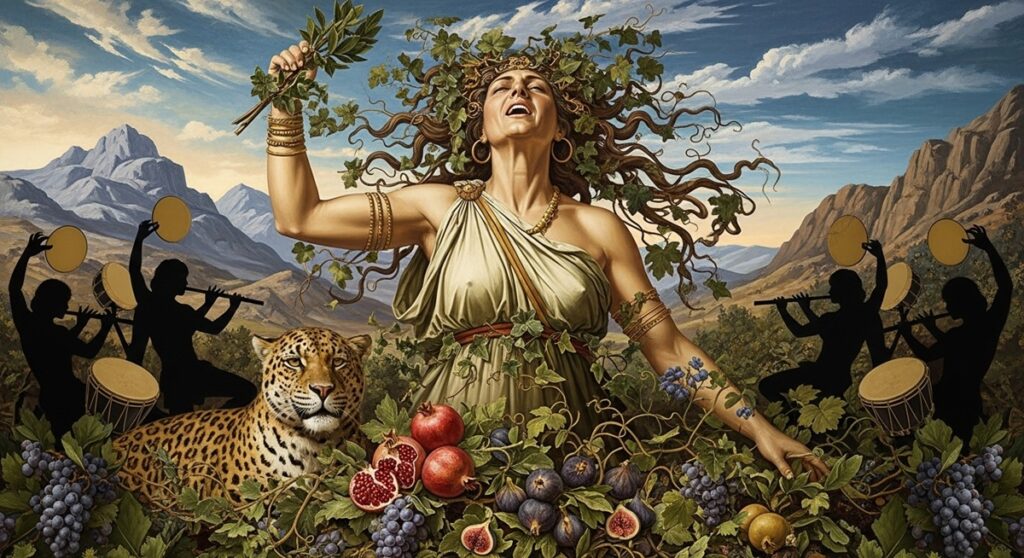
In modern Greece, Cybele‘s legacy surfaces in mountainous August 15th vigils, where ecstatic panigyria (feasts) honor Panagia with similar fervor. Her Anatolian origins remind us of Greece’s cross-cultural exchanges, enriching the sacred feminine narrative.
Artemis – Protector of Women and Wilderness
Artemis, the virgin huntress and guardian of childbirth, represented untamed nature and female autonomy. Festivals like the Arkteia were women-only rites marking transitions to womanhood, held in sacred groves.
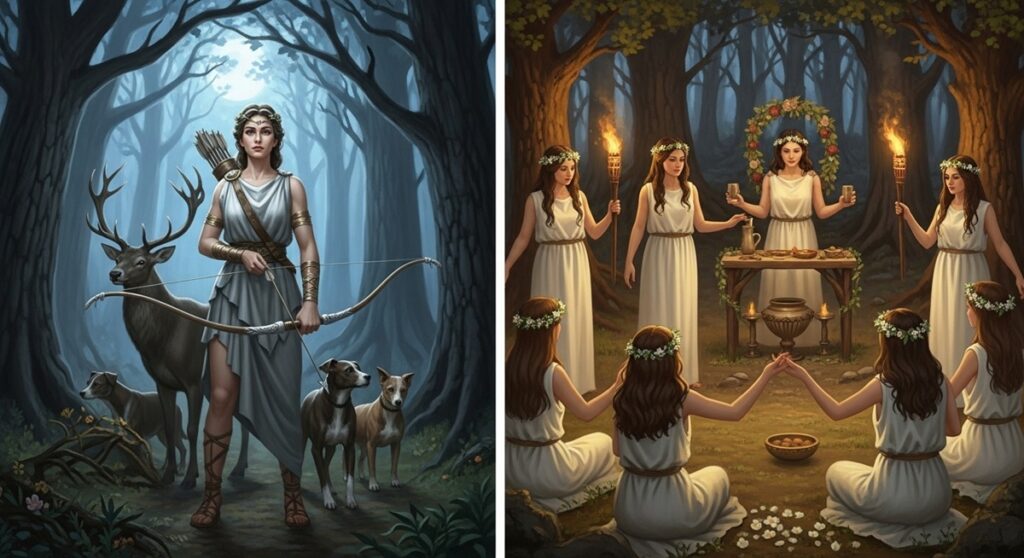
Parallels persist in Panagia‘s role as protector of mothers and children during August 15th. In remote areas, processions through wild landscapes invoke her aid, mirroring Artemis‘ wilderness domain. This blend underscores women’s central place in both myth and faith.
Aphrodite – Goddess of Love and Fertility
Born from sea foam, Aphrodite symbolized love, beauty, and procreation. Her Adonia festivals featured mourning and rejoicing, with doves as emblems of purity.
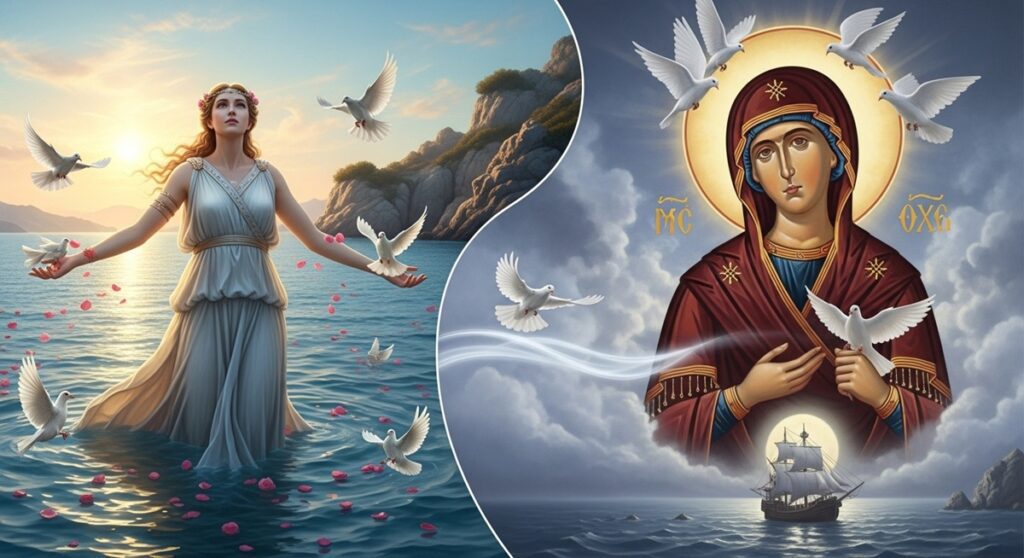
Panagia adopts similar motifs, as protector of sailors and embodiment of compassionate love. Doves in her iconography bridge these worlds, enhancing the holiday’s emotional depth.
Where Ancient and Modern Devotion Meet
Greece’s landscapes are living museums, where Greek mythology sites overlap with August 15th pilgrimage spots. These destinations offer travelers a chance to experience this fusion firsthand, from island hopping to mountain treks.
Tinos – The Lourdes of Greece
Dubbed Greece’s spiritual epicenter, Tinos hosts the miraculous icon of Panagia Evangelistria, drawing millions on August 15th. Pilgrims crawl on knees to the church, a display of devotion that rivals ancient healing sanctuaries.
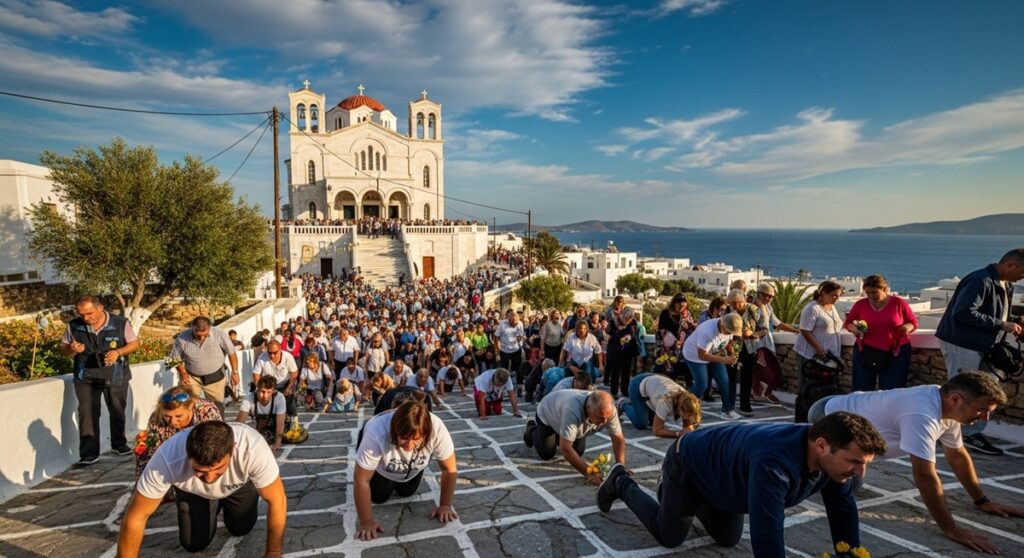
Mythologically, Tinos revered Poseidon and Amphitrite, sea deities whose protective essence lingers in Panagia‘s sailor patronage. Stay for the all-night vigils and feasts—it’s a sensory overload of faith and folklore.
Paros & Naxos – From Dionysus to the Virgin
On Paros, the Panagia Ekatontapiliani (Church of 100 Doors) hosts spectacular celebrations, with fireworks and music echoing Dionysian harvest revels. Dionysus, god of wine and ecstasy, was born on nearby Naxos, where his mythic marriage to Ariadne symbolized abundance.
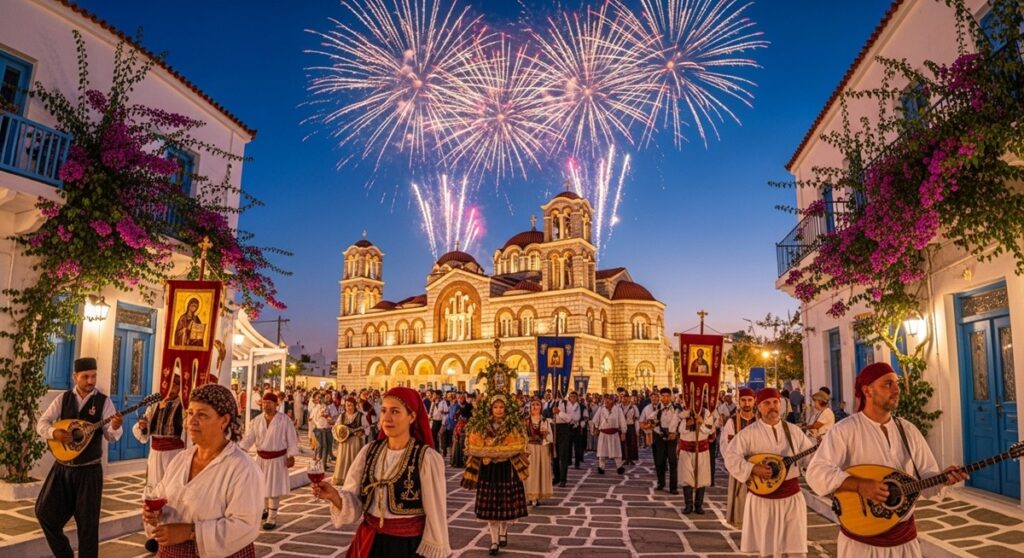
Today, August 15th blends these with Orthodox feasts, offering wine tastings amid processions. Hike to ancient temples, then join village panigyria for a mythical-modern mashup.
Pelion – Mountain of Centaurs and Saints
Pelion‘s lush peaks, home to wise centaur Chiron in myth, now dot with chapels where August 15th vigils unfold. Villages like Makrinitsa (“Balcony of Pelion”) and Portaria burst with dances and feasts, their rhythms evoking ancient rites.
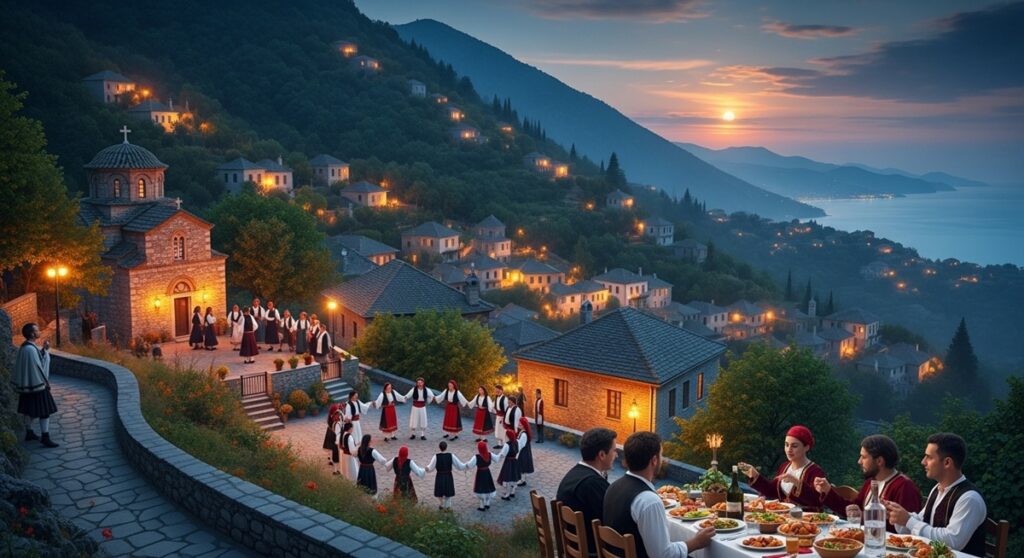
Here, Panagia protects shepherds, much like Artemis guarded wild realms. Wander stone paths, sample local tsipouro, and feel the continuity in every echo.
Epirus – Virgin of the Mountains
Rugged Epirus celebrates with mountain processions, where Panagia safeguards fields and springs. This echoes Athena and Artemis as protectors of skill and wilderness.
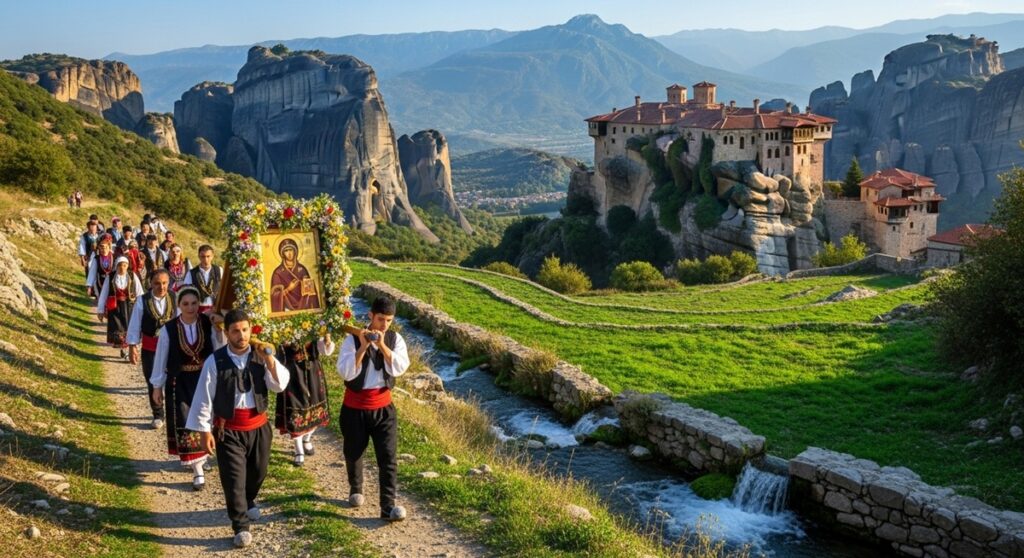
Visit Meteora’s monasteries for a spiritual high, blending myth with monastic serenity.
Ikaria – Island of Longevity and Legends
Ikaria‘s panigyria are legendary, with all-night parties honoring Panagia. Myth ties it to Icarus and Dionysus, whose wine cults mirror harvest blessings.
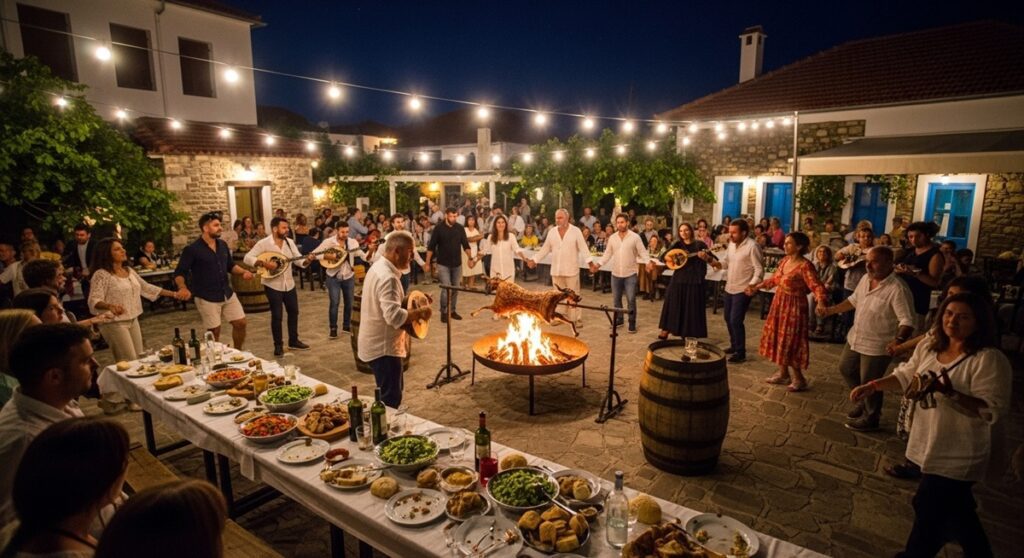
Experience rural feasts with goat roasts and dances—pure Greek hospitality.
Amorgos & Koufonissi – Cycladic Serenity
Amorgos’ Chozoviotissa Monastery clings to cliffs, hosting intimate August 15th services. Linked to Poseidon myths, it fuses sea protection with Marian devotion.
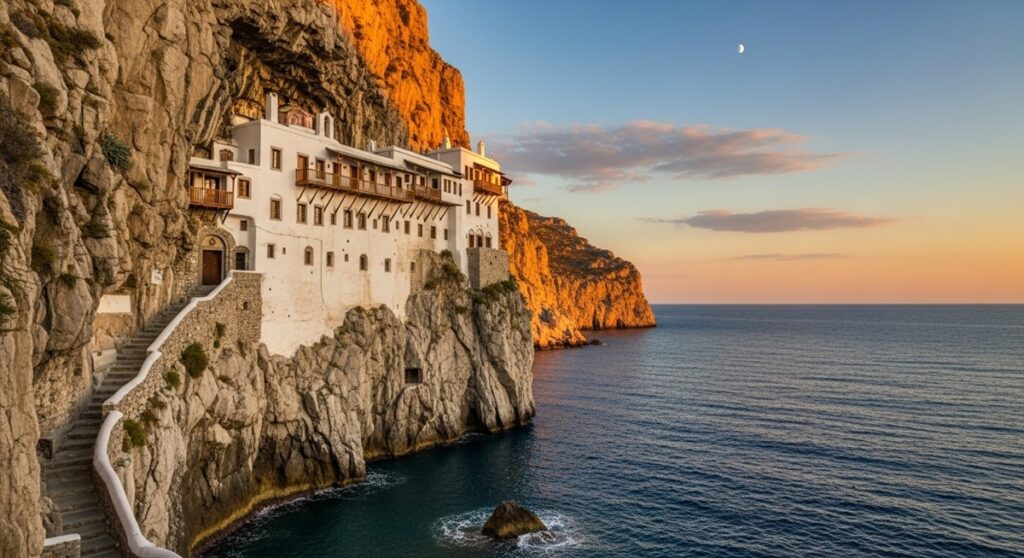
Nearby Koufonissi offers beachside celebrations, evoking Aphrodite’s foam-born origins.
Santorini – Volcanic Faith and Myth
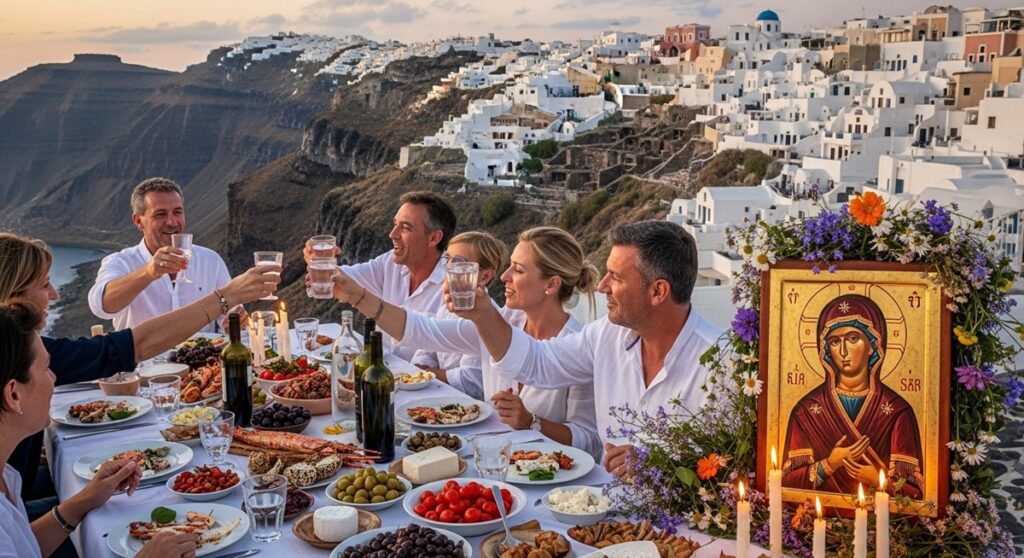
Santorini‘s feasts in Pyrgos and Fira blend volcanic drama with Panagia honors. Ancient Thera’s ruins recall Dionysian festivals, now overlaid with Christian joy.
Mount Olympus – Abode of Gods and Pilgrims
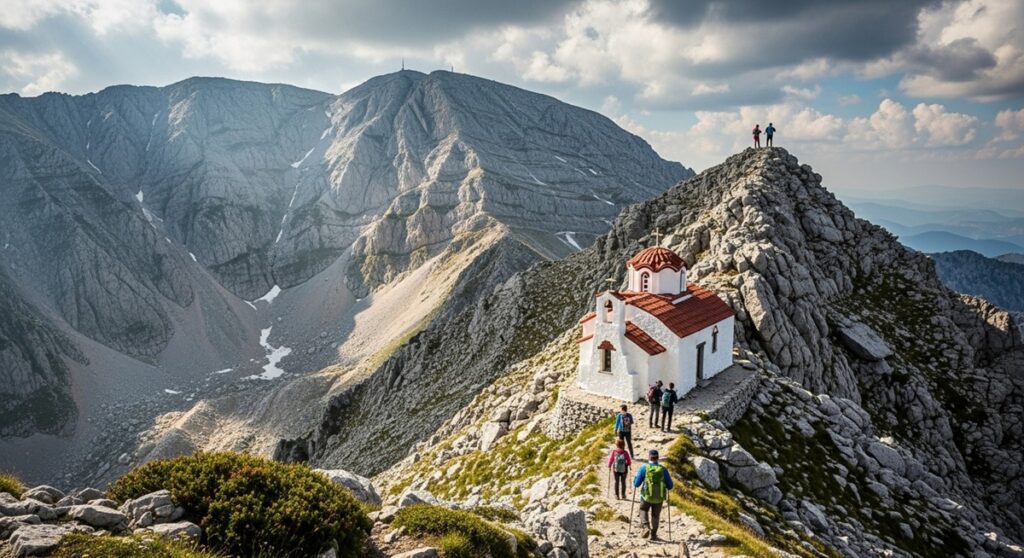
Climb Mount Olympus for chapels dedicated to Panagia, where August 15th pilgrimages honor her amid Zeus’s mythic throne. It’s a hike through divinity.
Kefalonia & Patmos – Island Mysteries
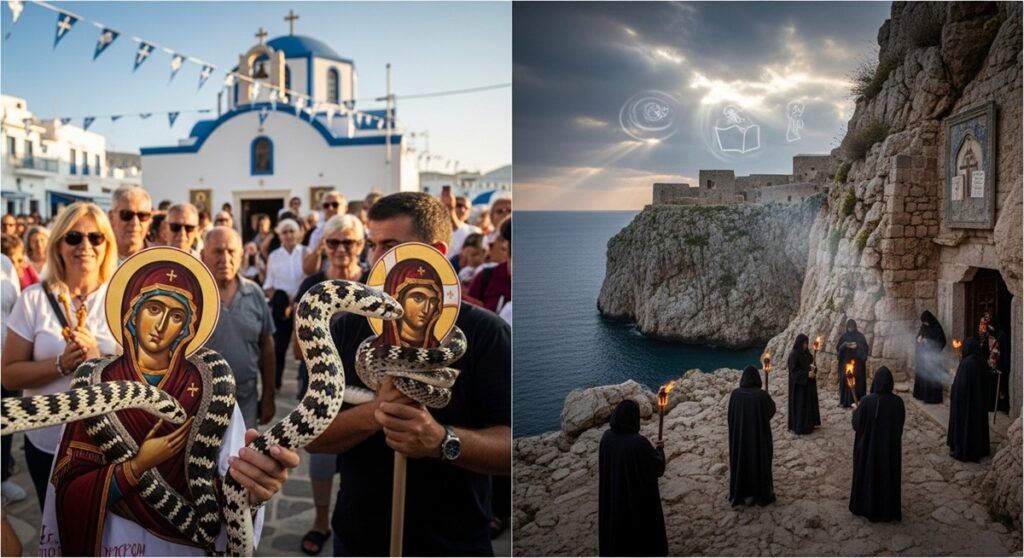
Kefalonia‘s “Snakes of the Virgin” phenomenon—harmless snakes appearing during festivities—links to ancient serpent symbols of renewal. Patmos, Revelation’s isle, hosts apocalyptic-themed celebrations.
Symbols That Bridge Ages
Symbols are the silent storytellers of this fusion, carrying meanings from Greek mythology to Orthodox iconography.
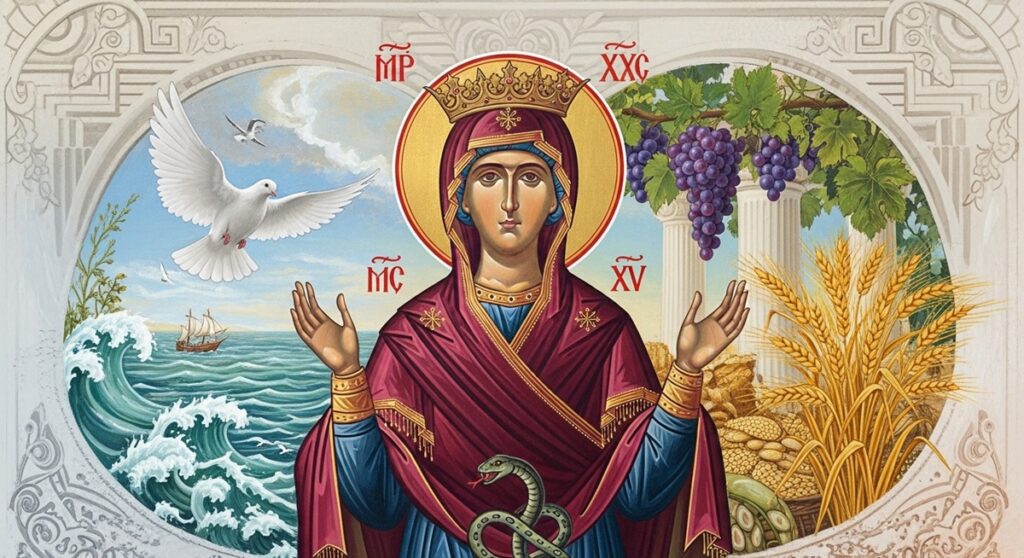
- The Dove: Sacred to Aphrodite for love, it signifies Panagia‘s purity in Christian art.
- The Sea: From Amphitrite’s waves to Panagia as sailors’ guardian, water represents birth and protection.
- The Harvest: Grapes and wheat, once for Demeter, now blessed for abundance.
- The Maphorion: Panagia‘s red-purple robe echoes married women’s attire, symbolizing divine maternity.
- Queen of Heaven: Like ancient “queen mothers,” Panagia reigns celestial, crowned with stars.
- The Serpent: In some icons, Panagia crushes serpents, evoking victory over chaos like ancient myths.
- The Orans Pose: Hands raised in prayer, linking to ancient oracles and Theotokos icons.
Travel Tips for Experiencing August 15th in Greece
Planning a trip? Here’s how to dive in authentically.
- Book Early: Ferries to islands like Tinos sell out months ahead; aim for June reservations.
- Dress Respectfully: Cover shoulders and knees for churches; women may need headscarves.
- Join the Panigyri: Post-service village feasts feature souvlaki, music, and dancing—embrace the chaos!
- Look for Old Ways: Spot pre-Christian customs like harvest offerings in rural spots.
- Itinerary Idea: Start in Athens, ferry to Paros for festivals, then Naxos for hikes; end in Tinos for the pilgrimage climax.
- Sustainable Travel: Use eco-ferries, support local artisans, and respect sites to preserve this heritage.
- Health & Safety: Hydrate in summer heat; check for COVID rules, though eased by 2025.
- Cultural Etiquette: Learn basic Greek phrases; participate humbly to connect deeply.
A Celebration of Continuity
August 15th in Greece is a vibrant continuum of the sacred feminine, from Gaia‘s earthy embrace to Panagia‘s heavenly grace. Amid processions and panigyria, you’ll witness how Greek mythology and Orthodox faith entwine, offering lessons in resilience, community, and wonder. As pilgrims ascend mountains or sail seas, they carry forward millennia of devotion. Visit, and you’ll leave transformed, carrying a piece of this eternal dance.


